Power electronic handbook
Подождите немного. Документ загружается.

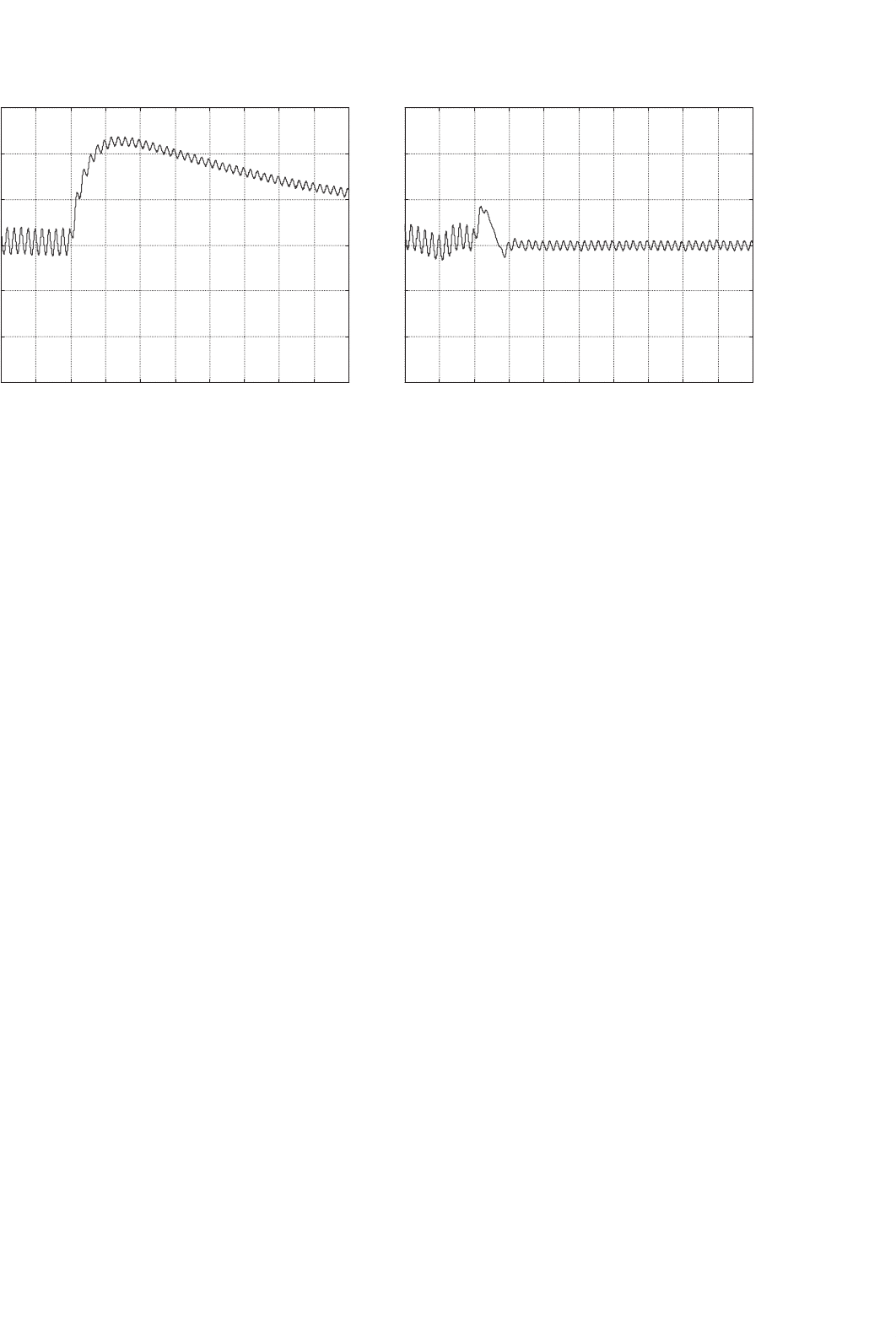
34 Control Methods for Switching Power Converters 997
0.2 0.25 0.3 0.35 0.4 0.45 0.5 0.55 0.6 0.65 0.7
77
78
79
80
81
82
83
Time [s]
Voltage [V]
0.2 0.25 0.3 0.35 0.4 0.45 0.5 0.55 0.6 0.65 0.7
77
78
79
80
81
82
83
Time [s]
Voltage [V]
(a) (b)
FIGURE 34.75 Simulated result of the output voltage response to load disturbances (R
o
= 50–150 at time 0.3 s): (a) PI control and (b) fuzzy logic
control.
Presently, fixed-frequency techniques were applied to convert-
ers that can only operate with fixed frequency. Sliding-mode
techniques were successfully applied to MIMO switching
power converters and to multilevel converters, solving the
capacitor voltage divider equalization. Sliding-mode control
needs more information from the controlled system than
do the linear controllers, but is probably the most ade-
quate tool to solve the control problem of switching power
converters.
Fuzzy logic controller synthesis was briefly presented. Fuzzy
logic controllers are based on human experience and intu-
ition and do not depend on system parameters or operating
points. Fuzzy logic controllers can be easily applied to various
types of power converters having the same qualitative dynam-
ics. Fuzzy logic controllers, like sliding-mode controllers, show
robustness to load and power supply perturbations, semi-
conductor non-idealities (such as switch delays or uneven
conduction voltage drops), and dead times. The controller
implementation is simple, if based on the off-line concept. On-
line implementation requires a fast microprocessor but can
include adaptive techniques to optimize the rule base and/or
the database.
Acknowledgments
J. Fernando Silva thanks all the researchers whose works
contributed to this chapter, namely Professors S. Pinto,
V. Pires, J. Quadrado, T. Amaral, M. Crisóstomo, Engineers
J. Costa, N. Rodrigues, and the suggestions of Professor M. P.
Kazmierkowski. The authors also thank FCT, POSI, POCTI,
FEDER for funding the projects enabling the presented results.
References
1. Bose, B. K. Power Electronics and AC Drives, Prentice-Hall,
New Jersey, 1986.
2. Kassakian, J. Schlecht, M. and Verghese, G. Principles of Power
Electronics, Addison Wesley, 1992.
3. Rashid, M. Power Electronics: Circuits, Devices and Applications, 2nd
ed., Prentice-Hall International, 1993.
4. Thorborg, K. Power Electronics, Prentice-Hall, 1988.
5. Mohan, N. Undeland, T. and Robins, W. Power Electronics: Convert-
ers, Applications and Design, 2nd ed., John Wiley & Sons, 1995.
6. Sum, K. K. Switched Mode Power Conversion, Marcel Dekker Inc.,
1984.
7. Bühler, H. Electronique de Réglage et de Commande, Traité
D’électricité, vol. XV, éditions Georgi, 1979.
8. Irwin, J. D. ed. The Industrial Electronics Handbook, CRC/IEEE Press,
1996.
9. Chryssis, G. High Frequency Switching Power Supplies, McGraw-Hill,
1984.
10. Labrique, F. and Santana, J. Electrónica de Potência, Fundação
Calouste Gulbenkian, Lisboa, 1991.
11. Utkin, V. I. Sliding Modes and Their Application on Variable Structure
Systems, MIR Publishers Moscow, 1978.
12. Utkin, V. I. Sliding Modes in Control Optimization, Springer-Verlag,
1981.
13. Ogata, K. Modern Control Engineering, 3rd ed., Prentice-Hall Inter-
national, 1997.
14. Levine, W. S. ed. The Control Handbook, CRC/IEEE Press, 1996.
15. Fernando Silva, J. Electrónica Industrial, Fundação Calouste
Gulbenkian, Lisboa, 1998.
16. Fernando Silva, J. Sliding Mode Control Design of Control and Modula-
tor Electronics for Power Converters, Special Issue on Power Electronics
of Journal on Circuits, Systems and Computers, vol. 5, no. 3,
pp. 355–371, 1995.
17. Fernando Silva, J. Sliding Mode Control of Boost Type Unity Power
Factor PWM Rectifiers, IEEE Trans. on Industrial Electronics,

998 J. F. Silva and S. F. Pinto
Special Section on High-Power-Factor Rectifiers I, vol. 46, no. 3,
pp. 594–603, June 1999. ISSN 0278-0046.
18. José Rodriguez, Special Section on Matrix Converters, IEEE Transac-
tions on Industrial Electronics, vol. 49, no. 2, April 2002.
19. Zadeh, L. A. “Fuzzy Sets”, Information and Control, vol. 8,
pp. 338–353, 1965.
20. Zadeh, L. A. “Outline of a New Approach to the Analysis of Com-
plex Systems and Decision Process,” IEEE Trans. Syst. Man Cybern.,
vol. SMC-3, pp. 28–44, 1973.
21. Zimmermann, H. J. Fuzzy Sets: Theory and its Applications, Kluwer-
Nijhoff, 1995.
22. Candel, A. and Langholz, G. Fuzzy Control Systems, CRC Press, 1994.

35
Fuzzy Logic in Electric Drives
Ahmed Rubaai, Ph.D.
Department of Electrical
Engineering, Howard University,
Washington, D.C., USA
35.1 Introduction ........................................................................................ 999
35.2 The Fuzzy Logic Concept ....................................................................... 999
35.2.1 The Fuzzy Inference System (FIS) • 35.2.2 Fuzzification • 35.2.3 The Fuzzy Inference
Engine • 35.2.4 Defuzzification
35.3 Applications of Fuzzy Logic to Electric Drives ............................................ 1005
35.3.1 Fuzzy Logic-based Microprocessor Controller • 35.3.2 Fuzzy Logic-based
Speed Controller • 35.3.3 Fuzzy Logic-based Position Controller
35.4 Hardware System Description ................................................................. 1008
35.4.1 Experimental Results
35.5 Conclusion .......................................................................................... 1011
Further Reading ................................................................................... 1013
35.1 Introduction
Over the years, we have increasingly been on the search to
understand the human ability to reason and make decisions,
often in the face of only partial knowledge. The ability to gen-
eralize from limited experience into areas as yet encountered is
one of the fascinating abilities of the human mind. Tradition-
ally, our attempt to understand the world and its functions
has been limited to finding mathematical models or equa-
tions for the systems under study. This approach has proven
extremely useful, particularly in an age when very fast comput-
ers are available to most of us with only a minimum amount
of capital outlay. And even when these computers are not fast
enough, many researchers can gain access to super computers
capable of giving numerical solutions to multiorder differential
equations that are capable of describing most of the industrial
processes.
This analytical enlightenment, however, has come at the cost
of realizing just how complex the world is. At this point, we
have come to realize that no matter how simple the system is,
we can never hope to model it completely. So instead, we select
suitable approximations that give us answers that we think, are
sufficiently precise. Because our models are incomplete, we are
faced with one of the following choices:
1. Use the approximate model and introduce probabilis-
tic representations to allow for the possible errors.
2. Seek to develop an increasingly complex model in the
hope that we can find one, that completely describes
the systems while being solvable in real time.
This dilemma has led a few, most notably Zadeh [1], to
return the decision-making process employed by our bril-
liant minds when confronted with incomplete information.
The approach taken in those cases makes allowances for the
imprecision caused by incomplete knowledge and actually
embracing the imprecision in forming an analytical frame-
work. This approach involved artificial intelligence using
approximate reasoning or fuzzy logic as it now commonly
known. As a result, artificial intelligence using fuzzy logic has
proven extremely useful in ascribing a logic mechanism to a
wide range of topics from economic modeling and prediction
to biology analysis to control engineering. In this chapter,
an examination of the principles involved in artificial intel-
ligence using fuzzy logic and its application to electric drives
is discussed.
35.2 The Fuzzy Logic Concept
Fuzzy logic arose from a desire to incorporate logical reason-
ing and the intuitive decision making of an expert operator
into an automated system [1]. The aim is to make decisions
based on a number of learned or predefined rules, rather than
999
Copyright © 2001 by Academic Press

1000 A. Rubaai
numerical calculations. Fuzzy logic incorporates rule-base
structure in attempting to make decisions [1–5]. However,
before the rule-base can be used, the input data should be
represented in such a way as to retain meaning, while, still
allowing for manipulation. Fuzzy logic is an aggregation of
rules, based on the input state variables condition with a cor-
responding desired output. A mechanism must exist to decide
on which output, or combination of the different outputs, will
be used since each rule could conceivably result in a different
output action.
Fuzzy logic can be viewed as an alternative form of
input/output mapping. Consider the input premise, x, and
a particular qualification of the input x represented by, A
i
.
Additionally, the corresponding output, y, can be qualified
by expression C
i
. Thus, a fuzzy logic representation of the
relationship between the input x and the output y could be
described with the following:
R
1
: IF x is A
1
THEN y is C
1
... ... ... ...
R
2
: IF x is A
2
THEN y is C
2
... ... ... ...
R
n
: IF x is A
n
THEN y is C
n
(35.1)
where
x is the input (state variable).
y is the output of the system.
A
i
are the different fuzzy variables used to classify the
input x.
C
i
are the different fuzzy variables used to classify the
output y.
The fuzzy rule representation is based on linguistic [1, 3].
Thus, the input x is a linguistic variable that corresponds
to the state variable under consideration. Furthermore, the
elements A
i
are fuzzy variables that describe the input x. Cor-
respondingly, the elements C
i
are the fuzzy variables used to
describe the output y. In fuzzy logic control, the term “lin-
guistic variable” refers to whatever state variables the system
designer is interested in [1]. Linguistic variables that are often
used in control applications include speed, speed error, posi-
tion, and derivative of position error. The fuzzy variable is
perhaps better described as a fuzzy linguistic qualifier. Thus
the fuzzy qualifier performs classification (qualification) of the
linguistic variables. The fuzzy variables frequently employed
include negative large, positive small, and zero. Several papers
in the literature use the term “fuzzy set” instead of “fuzzy
variable,” however, the concept remains the same. Table 35.1
illustrates the difference between fuzzy variables and linguistic
variables.
TABLE 35.1 Fuzzy and linguistic variables
Linguistic variables Fuzzy variables (linguistic
qualifiers)
Speed error (SE) Negative large (NL)
Position error (PE) Zero (ZE)
Acceleration (AC) Positive medium (PM)
Derivative of position error (DPE) Positive very small (PVS)
Speed (SP) Negative medium small (NMS)
Once the linguistic and fuzzy variables have been specified,
the complete inference system can be defined. The fuzzy lin-
guistic universe, U, is defined as the collection of all the fuzzy
variables used to describe the linguistic variables [6–8], i.e. the
set U for a particular system could be comprised of NS, ZE,
and PS. Thus, in this case the set U is equal to the set of [NS,
ZE, PS]. For the system described by Eq. (35.1), the linguistic
universe for the input x would be the set U
x
=[A
1
A
2
...A
n
].
Similarly, the linguistic universe for the output y would be the
set U
y
=[C
1
C
2
...C
n
].
35.2.1 The Fuzzy Inference System (FIS)
The basic fuzzy inference system (FIS) can be classified as:
Type 1 fuzzy input fuzzy output (FIFO)
Type 2 fuzzy input crisp output (FICO)
Type 2 differs from the first in that the crisp output values
are predefined and, thus, built into the inference engine of
the FIS. On the contrary, Type 1 produces linguistic outputs.
Type 1 is more general than Type 2 as it allows redefinition
of the response without having to redesign the entire infer-
ence engine. One draw back is the additional step required
converting the fuzzy output of the FIS to a crisp output.
Developing a FIS and applying it to a control problem
involves several steps:
1. Fuzzification.
2. Fuzzy rule evaluation (fuzzy inference engine).
3. Defuzzification.
The total FIS is a mechanism that relates the inputs to a
specific output or set of outputs. First, the inputs are catego-
rized linguistically (fuzziffication), then the linguistic inputs
are related to outputs (fuzzy inference), and finally, all the
different outputs are combined to produce a single output
(defuzziffication). Figure 35.1 shows a block diagram of the
fuzzy inference system.
35.2.2 Fuzzification
Fuzzification is the conversion of crisp numerical values into
fuzzy linguistic quantifiers’ [7, 8]. Fuzzification is performed
using membership functions. Each membership function eval-
uates how well the linguistic variable may be described by
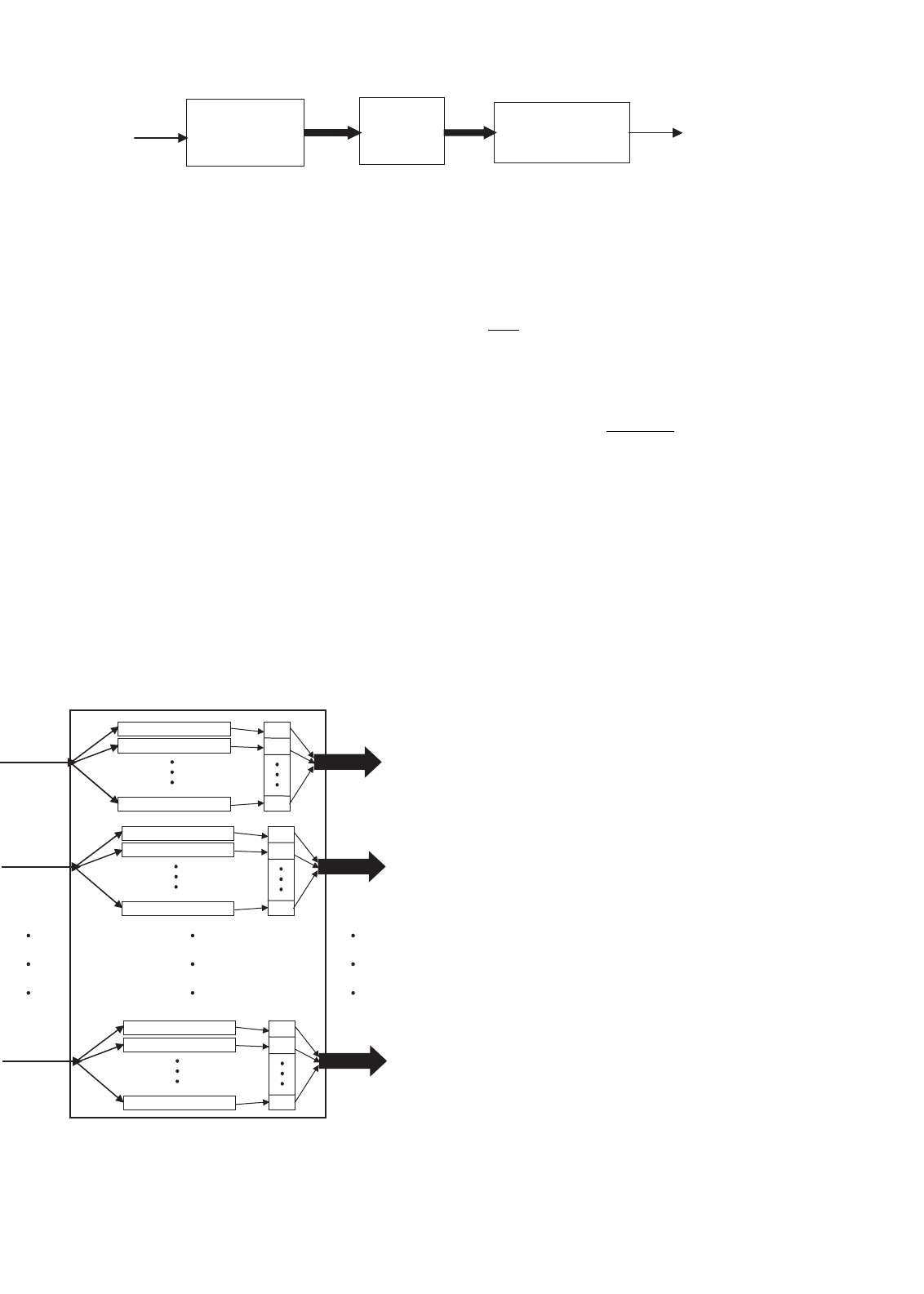
35 Fuzzy Logic in Electric Drives 1001
Crisp
Outputs
Fuzzy
Outputs
Fuzzification
Fuzzy
Inference
Engine
Defuzzification
Input/s
Fuzzy
Vectors
FIGURE 35.1 Fuzzy inference system.
a particular fuzzy qualifier. In other words, the membership
function derives a number that is representative of the suit-
ability of the linguistic variable to be classified by the fuzzy
variable (set). This suitability is often described as the degree of
membership. In order to maintain a relationship to traditional
binary logic, the membership values must range from 0 to 1
inclusive. Figure 35. 2 shows the mechanism involved in the
fuzzification of crisp inputs when multiple inputs are involved.
Since each input has a number of membership functions (one
for each fuzzy variable), the outputs of all the membership
functions for a particular crisp numerical input are combined
to form a fuzzy vector.
Any number of normalizing expressions can perform fuzzi-
fication. Two of the more common functions are the linear
and Gaussian [4]. In both cases there is one parameter, µ,
that indicates the midpoint of the region and another, σ, that
defines the width of the membership functions. For the lin-
ear function, the width is specified by, σ
L
, and the midpoint
by, µ
L
. Similarly for the gaussian function, the width is spec-
ified by, σ
G
, and the midpoint by, µ
G
. Equations (35.2a) and
Fuzzy Vector
Membership Function
Membership Function
Membership Function
Crisp Input-1
Fuzzy Vector
Membership Function
Membership Function
Membership Function
Crisp Input-2
For Input-2
Fuzzy Vector
For Input-n
Membership Function
Membership Function
Membership Function
Crisp Input-n
For Input-1
FIGURE 35.2 Fuzzification of the crisp numerical inputs.
(35.2b) define the linear and gaussian membership functions,
respectively.
Linear function:
1 −
x−µ
L
σ
L
if x ∈
[
(µ
L
−σ
L
), (µ
L
+σ
L
)
]
0 Otherwise
(35.2a)
Gaussian function:
exp
−
(
x − µ
G
)
2
2
(
σ
G
)
2
(35.2b)
where
µ
L
= µ
G
(35.3a)
σ
L
= 3σ
G
(35.3b)
The relations expressed by equations (35.3a) and (35.3b) are
made because of the characteristics of the gaussian function.
Because a gaussian membership function may never have a
membership value of zero, some appropriate value close to
zero must be chosen as the cut-off point. At a distance of 3σ
G
from the mean, the gaussian membership function results in
a membership value of 0.05. Thus the width of the gaussian
function is chosen as 3σ
G
.
As previously mentioned, fuzzification of the input has
resulted in a fuzzy vector where each component of this vector
represents the degree of membership of the linguistic vari-
ables into a specific fuzzy variable’s category. The number of
components of the fuzzy vector is equal to the number of
fuzzy variables used to categorize specific linguistic variable.
For illustrative purposes, we consider an example with a lin-
guistic variable x and three fuzzy variables PV, ZE, and NV.
If we describe the membership function (fuzzifier) as X, then
we will have three membership functions: X
PV
, X
ZE
, and X
NV
.
The fuzzy linguistic universe for the input x can be described
by the set U
x
that is defined in Eq. (35.4).
U
x
=
[
X
NV
X
ZE
X
PV
]
(35.4)
where
X
PV
is the membership function for the positive fuzzy
variables.
X
ZE
is the membership function for the zero fuzzy variables.
X
NV
is the membership function for the negative fuzzy
variables.
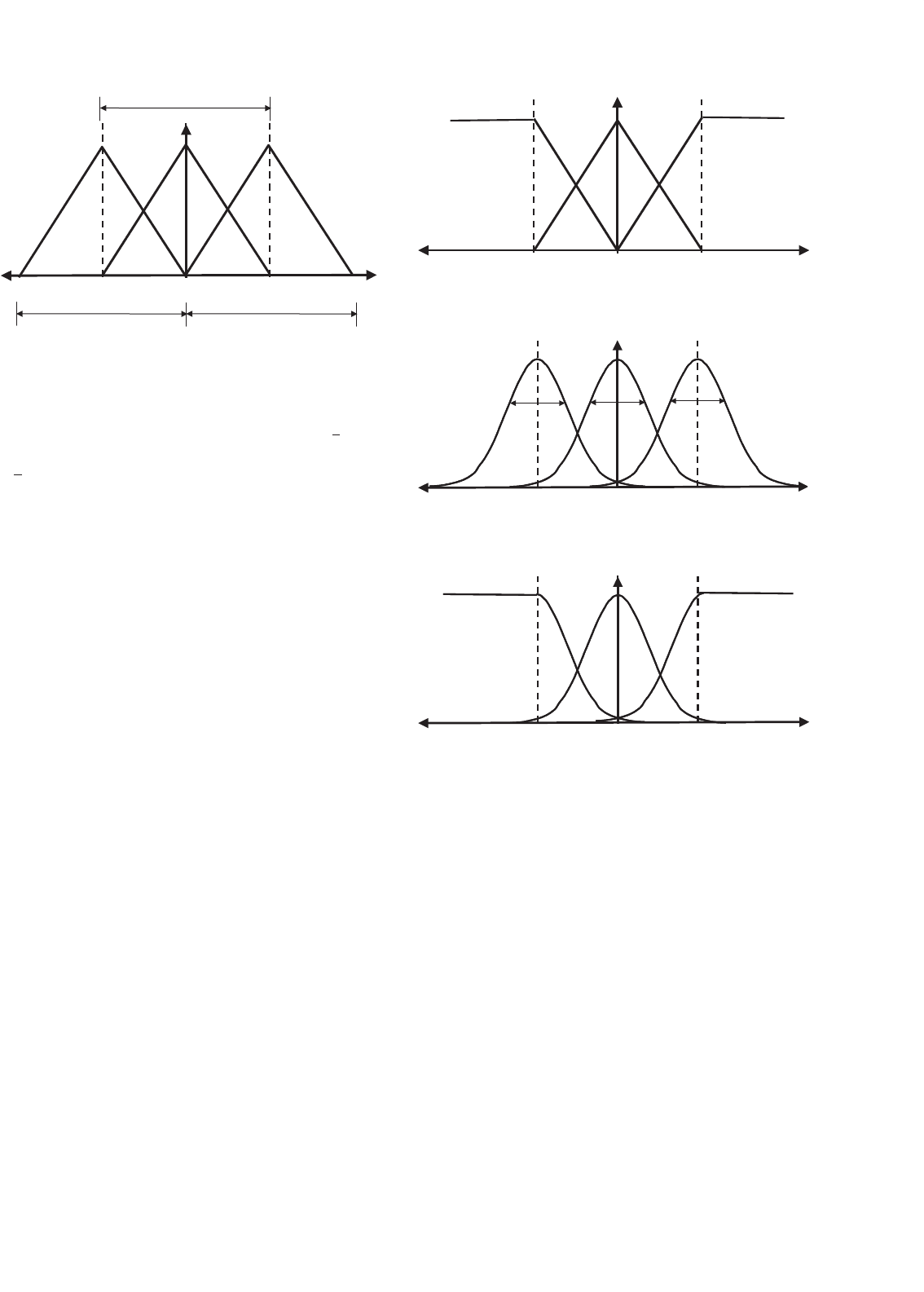
1002 A. Rubaai
1
X
ZE
X
PV
X
NV
σ
NV
µ
ZE
= 0
µ
NV
µ
PV
σ
PV
σ
ZE
FIGURE 35.3 Linear membership functions.
Thus, the fuzzy vector, which is the output of the fuzzifica-
tion step of the inference system, can be denoted by x
.
x
=
[
x
NV
x
ZE
x
PV
]
=
[
X
NV
(
x
)
X
ZE
(
x
)
X
PV
(
x
)
]
(35.5)
where
x
NV
= the membership value of x into the fuzzy region
denoted by negative.
x
ZE
= the membership value of x into the fuzzy region
denoted by zero.
x
PV
= the membership value of x into the fuzzy region
denoted by positive.
Equation (35.2a) represents the linear membership func-
tions, which are illustrated in Fig. 35.3. The linear function can
be modified to form the linear-trapezoidal function. Under
this modification, if the input x falls between zero and the
mean, µ
L
, of the respective region, then Eq. (35.2a) is used,
otherwise, the membership value is equal to one. Thus, we
arrive at the membership functions shown in Fig. 35.4. Each
region of the linear and trapezoidal-linear membership func-
tions is distinguished from another by the different values of
σ
L
and µ
L
. One important criterion that should be taken into
consideration is that the union of the domain of all member-
ship functions for a given input must cover the entire range
of the input [9]. Thus the trapezoidal modification is often
employed to ensure coverage of the entire input space.
The gaussian membership function is characterized by
Eq. (35.2b). The gaussian function can also be modified to
form the trapezoidal-gaussian function. In this case, if the
input falls between the mean, µ
G
and zero, Eq. (35.2b) is
used to find the membership value. Otherwise the member-
ship value becomes one. The gaussian function is shown in
Fig. 35.5 and the modified version is shown in Fig. 35.6.
A third type of membership function known as the fuzzy
singleton is also considered. The fuzzy singleton is a special
function in which the membership value is one for only one
X
PV
X
NV
1
0
X
ZE
FIGURE 35.4 Linear-trapezoidal membership functions.
X
ZE
X
PV
X
NV
1
µ
ZE
= 0
σ
NV
µ
NV
µ
PV
σ
ZE
σ
PV
FIGURE 35.5 Gaussian membership functions.
X
ZE
X
PV
X
NV
1
FIGURE 35.6 Gaussian-trapezoidal membership functions.
particular value of the linguistic input variable, and zero oth-
erwise [4]. Thus, the fuzzy singleton is a special case of the
membership function with a width, σ, of zero. Therefore, the
only parameter that needs to be defined is the mean, µ
s
,of
the singleton. Thus, if the input is equal to µ
s
, then the mem-
bership value is one. Otherwise it is zero. We can denote the
singleton membership function as S(µ
s
).
The fuzzy singleton function is quite useful in defining some
special membership functions. If we would like to dispense
with the need for a continuous degree of membership and
prefer a binary valued function, the fuzzy singleton is an ideal
candidate. We can form the membership function represent-
ing the fuzzy variable as a collection of fuzzy singletons ranging
within the regions denoted by [µ+σ/2, µ −σ/2]. A graphical
representation using three fuzzy variables (membership func-
tions) is shown in Fig. 35.7 (in Fig. 35.7 the corners are only
slanted so that the regions are easier to distinguish from each
other). Thus, the membership functions shown in Fig. 35.7
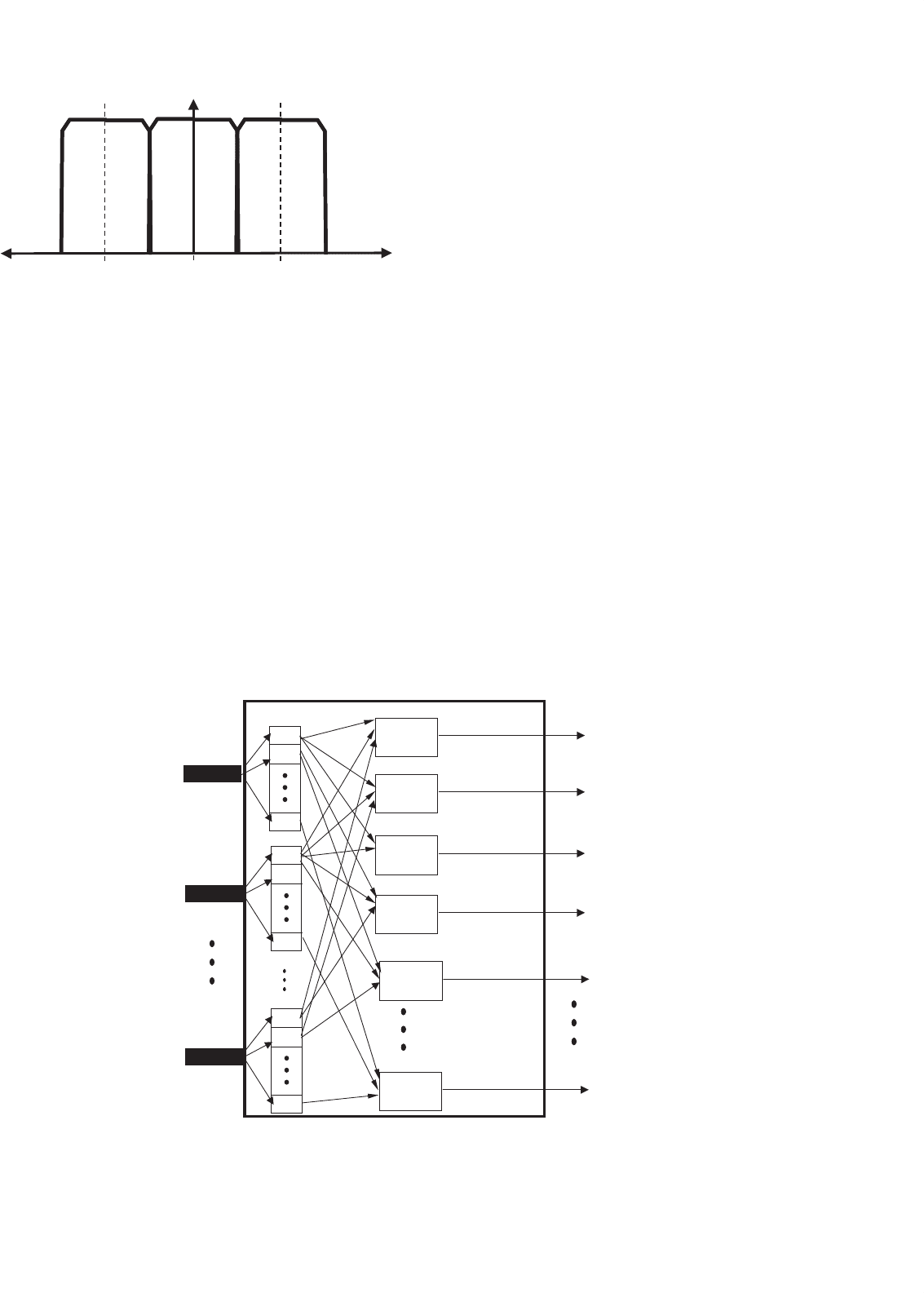
35 Fuzzy Logic in Electric Drives 1003
1
0
X
ZE
X
PV
X
NV
FIGURE 35.7 Membership functions comprised of fuzzy singletons.
would be best defined as an integral of the fuzzy singleton
with respect to the mean over the width of the function. Con-
sequently, the membership function X (σ,µ) would be defined
as follows:
X(σ, µ) =
µ+σ/2
µ−σ/2
S(µ
s
)dµ
s
(35.6)
where
S(µ
s
) is the singleton function.
35.2.3 The Fuzzy Inference Engine
The fuzzy inference engine uses the fuzzy vectors to evaluate
the fuzzy rules and produce an output for each rule. Figure 35.8
Fuzzy Vector
For Input-1
Rule -1
Fuzzy Vector
For Input-2
Fuzzy Vector
For Input-i
Rule -2
Rule -3
Rule -4
Rule -5
Rule -k
(w
3
, y
3
)
(w
4
, y
4
)
(w
5
, y
5
)
(w
k
, y
k
)
(w
1
, y
1
)
(w
2
, y
2
)
Fuzzy Outputs
FIGURE 35.8 Fuzzy inference engine.
shows a block diagram of the fuzzy inference engine. Note that
the rule-based system takes the form found in Eq. (35.1). This
form could be applied to traditional logic as well as fuzzy logic
albeit with some modification. A typical rule R would be:
R
i
: IF x
i
THEN y = C
i
(35.7)
where
x
i
is the result of some logic expression.
The logical expression used in the case of fuzzy inference
Eq. (35.7) is of the form
x ∈ X
i
(35.8)
where
x is the input.
X
i
is the linguistic variable.
In binary logic, the expression in Eq. (35.8) results in either
true or false. However, in fuzzy logic we often require a con-
tinuum of truth-values. Figures 35.9 and 35.10 illustrate the
difference between binary logic and fuzzy logic. In traditional
logic, there is a single point representing the boundary between
true and false. While in fuzzy logic, there is an entire region
over which there is a continuous variation between truth and
falsehood. The second part of Eq. (35.7), y = C
i
, is the action
prescribed by the particular rule. This portion indicates what
value will be assigned to the output. This value could be either
a fuzzy linguistic description or a crisp numerical value.
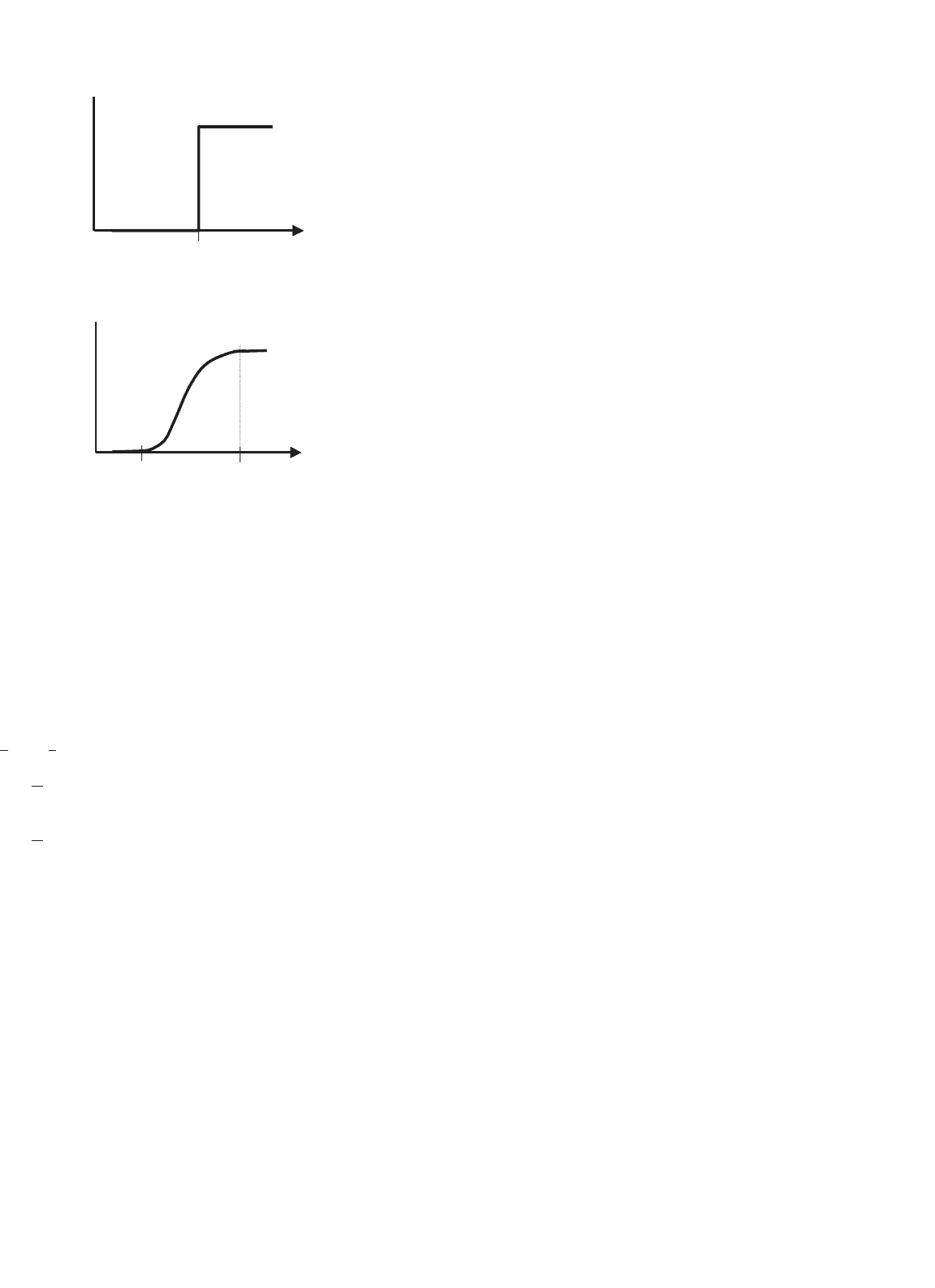
1004 A. Rubaai
Threshold Point
True
False
Conditional
Statement
FIGURE 35.9 Binary logic statement evaluation.
Threshold Region
True
False
Conditional
Statement
FIGURE 35.10 Fuzzy logic statement evaluation.
The logical expression that dictates whether the result of a
particular rule is carried out could involve multiple criteria.
Multiple conditions imply multiple input, as is most often the
case in many applications of fuzzy logic to dynamic systems.
Let us describe a system with two inputs x
1
and x
2
. For sim-
plicity of explanation and without loss of generality, we will
use three fuzzy variables, namely, PV, ZE, and NV. Although
each linguistic variable x
1
and x
2
uses the same fuzzy qualifiers,
each input must have its own membership functions since they
belong to different spaces. Thus, we will have two fuzzy vectors
x
1
and x
2
, for the first and second input, respectively.
X
1
=X
1
NV
(x
1
) X
1
ZE
(x
1
) X
1
PV
(x
1
)=x
1
1
x
1
2
x
1
3
(35.9a)
X
2
=X
2
NV
(x
2
) X
2
ZE
(x
2
) X
2
PV
(x
2
)=x
2
1
x
2
2
x
2
3
(35.9b)
where
X
n
NV
= Membership function for the negative fuzzy variable
for input n.
X
n
ZE
= Membership function for the zero fuzzy variable for
input n.
X
n
PV
= Membership function for the positive fuzzy variable
for input n.
x
1
= First linguistic variable (input-1).
x
2
= Second linguistic variable (input-2).
x
1
i
= The degree of membership of input-1 into the ith
fuzzy variable’s category.
x
2
j
= The degree of membership of input-2 into the jth
fuzzy variable’s category.
The inference mechanism in this case would be specified by
the rule R
ij
:
R
ij
: IF (x
1
i
AND x
2
j
) THEN y = C
ij
(35.10)
The specification R
ij
is made so as to emphasize that all com-
binations of the components of the fuzzy vectors should be
used in separate rules. A specific example of one of the rules
can be described as follows:
R
13
IF (x
1
1
AND x
2
3
THEN y = C
13
This rule can be written linguistically as:
R
13
IF((x
1
is Negative) AND (x
2
is Positive))THEN y = C
13
where
x
1
is the first linguistic variable.
x
2
is the second linguistic variable.
C
13
is the output action to be defined by the system designer.
The AND in Eq. (35.10) can be interpreted and evaluated in
two different ways. First, the AND could be evaluated as the
product of x
1
i
and x
2
j
[7]. Thus,
x
1
i
AND x
2
j
= x
1
i
x
2
j
The second method is by taking the minimum of the term’s
[7]. In this case the result is the minimum value of the
membership values. Therefore,
x
1
i
AND x
2
j
= min(x
1
i
, x
2
j
)
The most commonly used method in the literature is the prod-
uct method. Therefore, the product method is used in this
chapter to evaluate the AND function. Equation (35.10) can
be expanded to multiple input with multiple fuzzy variables.
In the most general case of n inputs and k linguistic qualifiers,
we would have the rule R
i
:
R
i
: IF [x
1
i
AND x
2
i
AND ... AND x
n
i
] THEN y = C
i
(35.11)
Recalling that all combinations of input vector components
must be taken between fuzzy vector components the system
designer could have up to n*k rules. Where n is the number of
fuzzy variables used to describe the inputs and k is the number
of inputs. The number of rules used by the fuzzy inference
engine could be reduced if the designer could eliminate some
combinations of input conditions.

35 Fuzzy Logic in Electric Drives 1005
35.2.4 Defuzzification
The fuzzy inference engine as described previously often has
multiple rules, each with possibly a different output. Defuzzifi-
cation refers to the method employed to combine these many
outputs into a single output. Using Eq. (35.11) where multiple
inputs (x
1
x
2
... x
n
) should be evaluated, the product due to
the evaluation of the premise conditions (defined by the com-
ponents of the fuzzy vectors) determines the strength of the
overall rule evaluation, w
i
.
w
i
= x
1
i
AND x
2
i
AND ...AND x
n
i
w
i
= (x
1
i
)(x
2
i
) ...(x
n
i
) (35.12)
where, x
k
i
is the membership value of the kth input into the
ith fuzzy variable’s category.
This value, w
i
, becomes extremely important in defuzzi-
fication. Ultimately, defuzzification involves both the set of
outputs C
i
and the corresponding rule strength w
i
.
There are a number of methods used for defuzzification,
including the center of gravity (COG) and mean of maxima
(MOM) [10]. The COG method otherwise known as the fuzzy
centroid is denoted by y
COG
.
y
COG
=
i
w
i
C
i
i
w
i
(35.13)
where
w
i
=
k
x
k
i
C
i
: is the corresponding output.
The mean of maxima method selects the outputs C
i
that
have the corresponding highest values of w
i
.
y
MOM
=
C
i
∈G
C
i
Card(G)
(35.14)
where, G denotes a subset of C
i
consisting of these values
that have the maximum value of w
i
. Out of the two meth-
ods of defuzzification, the most common method is the fuzzy
centroid and is the one employed in this chapter.
35.3 Applications of Fuzzy Logic to
Electric Drives
High performance drives requires that the shaft speed and
the rotor position follow preselected tracks (trajectories) at all
times [11, 12]. To accomplish this, two fuzzy control systems
were designed and implemented. The goal of fuzzy control sys-
tem is to replace an experienced human operator with a fuzzy
rule-based system. The fuzzy logic controller provides an algo-
rithm that converts the linguistic control maneuvering, based
on expert knowledge, into an automatic control approach. In
this section, a fuzzy logic controller (FLC) is proposed and
applied to high performance speed and position tracking of a
brushless DC (BLDC) motors. The proposed controller pro-
vides the high degree of accuracy required by high performance
drives without the need for detailed mathematical models. A
laboratory implementation of the fuzzy logic-tracking con-
troller using the Motorola MC68HC11E9 microprocessor is
described in this chapter. Additionally, in this experiment a
bang–bang controller is compared to the fuzzy controller.
35.3.1 Fuzzy Logic-based Microprocessor
Controller
The first step in designing a fuzzy controller is to decide which
state variables representative of system dynamic performance
can be taken as the input signals to the controller. Further,
choosing the proper fuzzy variables, formulating the fuzzy
control rules are also significant factors in the performance
of the fuzzy control system. Empirical knowledge and engi-
neering intuition play an important role in choosing fuzzy
variables and their corresponding membership functions. The
motor drive’s state variables and their corresponding errors are
usually used as the fuzzy controller’s inputs including, rotor
speed, rotor position, and rotor acceleration. After choosing
proper linguistic variables as input and output of the fuzzy
controller, it is required to decide on the fuzzy variables to be
used. These variables transform the numerical values of the
input of the fuzzy controller, to fuzzy quantities. The num-
ber of these fuzzy variables specifies the quality of the control,
which can be achieved using the fuzzy controller. As the num-
ber of the fuzzy variable increases, the management of the rules
is more involved and the tuning of the fuzzy controller is less
straightforward. Accordingly, a compromise between the qual-
ity of control and computational time is required to choose the
number of fuzzy variables. For the BLDC motor drive under
study, two inputs are usually required. After specifying the
fuzzy sets, it is required to determine the membership func-
tions for these sets. Finally, the fuzzy logic control (FLC) is
implemented by using a set of fuzzy decision rules. After the
rules are evaluated, a fuzzy centroid is used to determine the
fuzzy control output. Details of the design of the proposed
controllers are given in the following sections.
35.3.2 Fuzzy Logic-based Speed Controller
In the case of shaft speed control to achieve optimal tracking
performance, the motor speed error (ω
e
) and the motor accel-
eration error (α
e
) are used as inputs to the proposed controller.
The controller output is the change in the motor voltage. For
the fuzzy logic-based speed controller, the two inputs required

1006 A. Rubaai
are defined as
ω
e
= ω
ref
−ω
act
(35.15)
α
e
= α
ref
−α
act
(35.16)
where
ω
ref
= the desired speed (rad/s).
ω
act
= the measured speed (rad/s).
α
ref
= 0, because we want to minimize the acceleration to
zero.
α
act
= the calculated acceleration in (rad/s
2
).
For both the speed and acceleration errors, three regions
of operation are established according to the fuzzy variables.
These regions are positive error, zero, and negative error.
The proposed controller uses these regions to determine the
required motor voltage, which enables the motor speed to fol-
low a desired reference trajectory. Examples of the broad fuzzy
decisions are:
IF speed error is positive, THEN decrease the output.
IF speed error is zero, THEN maintain the output.
IF speed error is negative, THEN increase the output.
IF acceleration error is positive, THEN decrease the output.
IF acceleration error is zero, THEN maintain the output.
IF acceleration error is negative, THEN increase the output.
To achieve a sufficiently good quality of control, the three
basic variables must be further refined. Thus the linguistic
variable “acceleration error” has seven fuzzy variables: negative
large (NL), negative medium (NM), negative small (NS), zero
(Z), positive small (PS), positive medium (PM), and positive
large (PL). The values associated with the fuzzy variables for
the acceleration error are shown in Table 35.2.
The linguistic variable “speed error” has nine fuzzy vari-
ables: negative large (NL), negative medium (NM), negative
medium small (NMS), negative small (NS), zero (Z), pos-
itive small (PS), positive medium (PM), positive medium
small (PMS), and positive large (PL). Two fuzzy sets, namely,
negative medium small (NMS) and positive medium small
(PMS) are added to enhance the tracking performance. The
TABLE 35.2 Fuzzy variables for the acceleration error (α
e
) for speed
control
Fuzzy variable Acceleration error (rad/s
2
)
(NL) α
e
≤−738
(NM) −738 <α
e
≤−369
(NS) −369 <α
e
< 0
(ZE) α
e
= 0
(PS) 0 <α
e
< 369
(PM) 369 ≤ α
e
< 738
(PL) 738 ≤ α
e
TABLE 35.3 Fuzzy variables for the speed error (ω
e
) for speed control
Fuzzy variable Speed error (rad/s)
(NL) ω
e
≤−209
(NM) −209 <ω
e
≤−104
(NMS) −104 <ω
e
≤−49
(NS) −49 <ω
e
< 0
(Z) ω
e
= 0
(PS) 0 <ω
e
< 49
(PMS) 49 ≤ ω
e
< 104
(PM) 104 ≤ ω
e
< 209
(PL) 209 ≤ ω
e
regions defined for each fuzzy variable for the speed error is
summarized in Table 35.3.
After specifying the fuzzy sets, it is required to determine
the membership functions for these sets. The membership
function for the fuzzy variable-representing ZERO is a fuzzy
singleton. Additionally, the other membership functions are
of the type described in Eq. (35.6) and are composed of
fuzzy singletons within the region defined for each particu-
lar fuzzy variable. Figures 35.11 and 35.12 show the resulting
membership function for the acceleration and speed errors,
respectively.
The two fuzzy sets illustrated in Figs. 35.11 and 35.12 result
in 63 linguistic rules for the BLDC drive system under study.
The conditional rules listed in Table 35.4 are clearly implied,
and the physical meanings of some rules are briefly explained
as follows:
Rule 1: IF speed error is PL AND acceleration is PS, THEN
change in control voltage (output of fuzzy controller) is PL.
This rule implies a general condition when the measured speed
is far from the desired reference speed. Accordingly, it requires
a large increase in the control voltage to force the shaft speed
to the desired reference speed quickly.
Rule 2: IF speed error is PS AND acceleration is ZERO,
THEN change in control voltage is positive very very small
PVVS. This rule implements the conditions when the error
starts to decrease and the measured speed is approaching the
desired reference speed. Consequently, a very small increase in
the control voltage is applied.
Rule 3: IF speed error is ZERO AND acceleration is NS,
THEN change in control voltage is PVVS. This rule deals with
the circumstances when overshoot does occur. A very small
decrease in the control voltage is required, which brings the
motor speed to the desired reference speed.
These rules comprise the decision mechanism for the fuzzy
speed controller. The decision table, Table 35.4, consists of val-
ues showing the different situations experienced by the drive
system and the corresponding control input functions. It is
clear that each entry in Table 35.4 represents a particular rule.
Now it is necessary to find the fuzzy output (change in
control voltage). In this experiment the fuzzy centroid is used.
